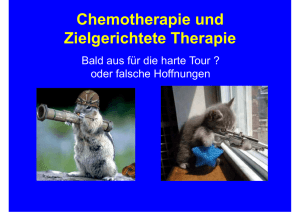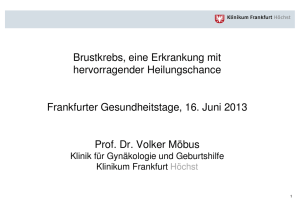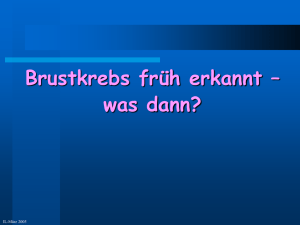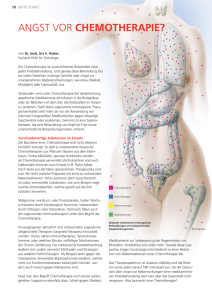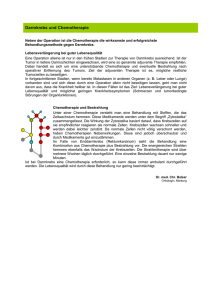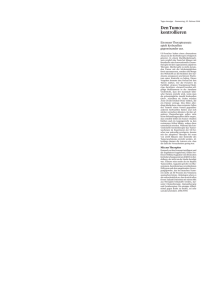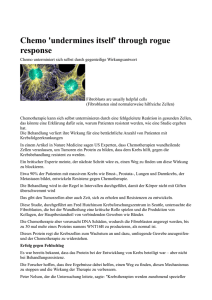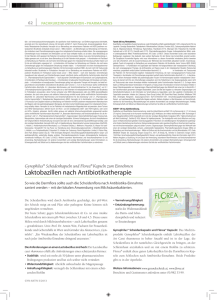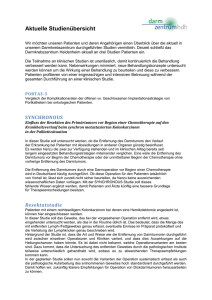Chemotherapie_2006
Werbung
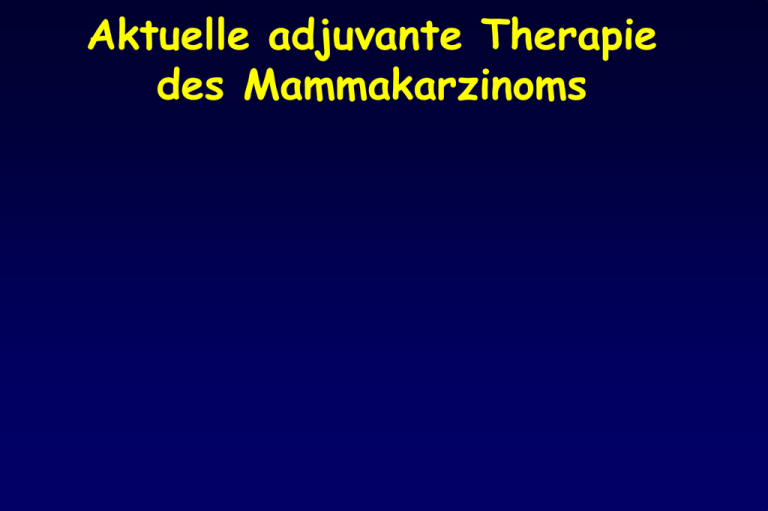
Aktuelle adjuvante Therapie des Mammakarzinoms Adjuvante Chemotherapie des Mammakarzinoms • Welche Substanzen????? • Welches Chemotherapieregime?? • Welche Dauer? • Welche Dosisintensität???? Primäre systemische Therapie Adjuvante systemische Therapie Adjuvante vs. primär systemische Therapie Was wird wie chemotherapiert Angaben in % Adjuvant (n=370) Neoadjuvant (n=49) 35 15 45 55 CMF Anthrazyklin-Taxan-basiert Topotecan-basiert unbekannt 33 2 24 6 Anthrazyklin-basiert Alkylanz-basiert Mitomycin-basiert C. Jackisch St. Gallen 2005: Risikokategorien Mammakarzinom Nodal negativ – Nodal positiv (1-3 LK+) Niedriges Risiko Mittleres Risiko p T 2 cm (invasive Komponente) + Grading 1 + Alter 35 Jahre + V0 + Keine Her2neu Überexpression oder Amplifikation p T > 2 cm (invasive Komponente) oder Grading 2-3 oder Alter < 35 Jahre oder V1 oder Her2neu Überexpression oder Amplifikation N1-3+ (+ Her2neu negativ) Goldhirsch A. et al Ann Oncol epub Sept 7, 2005 * <1% Verbesserung des DFI @10 Jahre St. Gallen 2005: Risikokategorien Mammakarzinom Nodal positiv Hohes Risiko (≥4 LK+) Jedes N + und zusätzlich L1 oder V1 oder Her2neu Überexpression SYSTEMTHERAPIE NODAL NEGATIV NODAL POSITIV REZEPTOR REZEPTOR NEGATIV POSITIV REZEPTOR REZEPTOR NEGATIV POSITIV C H T Endokrine C H T Therapie Endokrine Therapie C H T Endokrine C H T Therapie Endokrine Therapie Adjuvante Chemotherapie Dann aber auch richtig… SYSTEMISCHE THERAPIE Qualität + Quantität = ÜBERLEBEN RFS & OS 20 Jahre nach Mastektomie (CMF N+) 65-84 % < 65 % control Jahre nach Mastektomie Probability of OS > 85 % 65-84 % < 65 % control Probability of RFS > 85 % Jahre nach Mastektomie C. Jackisch Bonadonna J et al N Engl J Med 1995;332:901-906 RTDI < 85% CMF 15.4% E/A 15.6% Gesamt 15.4% > 85% 84.6% 84.4% 84.6% RTDI Strahlentherapie + CHT keine oder nach vor oder während* < 85% 8.2% 18.4% > 85% 91.8% 81.6% X2 = 3.82; df = 1; *p = 0.05 Jackisch C et al. Geburtsh Frauenheilk 2003 Adjuvante Chemotherapie Wenn die Indikation stimmt, ist das Alter keine KI… Chemotherapie bei älteren Patienten Erkrankungsfreies Überleben - nach Therapie und Alter Muss et al, ASCO 2003, #11 C. Jackisch Therapie des Mammakarzinoms „Elderly Women ≥ 80 Jahre“ 1.0 Breast-conserving surgery plus adjuvant therapy .9 Mastectomy + adjuvant therapy .8 Cumulative Survival Mastectomy Tamoxifen .7 Breast-conserving surgery alone .6 .5 Miscellaneous n=407 (1989-1999) Geneva Cancer Registry .4 No treatment .3 0 1 2 3 4 5 Years After Diagnosis Bouchardy C J Clin Oncol 2003;21:3580-3587 C. Jackisch Adjuvante Chemotherapie FLOPS & TOPS… Adjuvante Chemotherapie Mamma - CA Weiterentwicklung der Regime 6 x CMF 4 x AC 4 x A 3 x CMF; 4 x EC 3 x CMF 6 x FEC 4 x AC 4 x Paclitaxel 4 x Docetaxel 6 x TAC; 3 x FEC T; 4 x AT 3 x CMF 6 x Carboplatin/Docetaxel Dosisdichte Regime (CALGB, AGO) Chemotherapie plus Trastuzumab Anthracycline vs CMF Metaanalyse Rezidivfreies Überleben Gesamtüberleben Kumulative Wahrscheinlichkeit (%) 100 80 68,0 61,4 60 63,4 57,9 40 Anthrazyklinhaltige Therapie 20 CMF 0 0 5 Nachbeobachtungszeit (Jahre) 10 0 5 nach EBCTCG, Oxford 2000 10 Adjuvante Chemotherapie Nodal negativ… Risikoevaluation N0 • 50 % aller Mammakarzinome sind N0 • 45 % aller nodalnegativen Mammakarzinome haben ein erhöhtes Rezidivrisiko • Proteasen (uPA/PAI-1) sind an der Matrixdegradierung und der konsekutiven Metastasierung beteiligt • N0 • 45 % erhöhte uPA und/oder PAI-1-Konz. • 55 % erniedrigte uPA und/oder PAI-1-Konz. C. Jackisch Adjuvante Chemotherapie Nodal positiv… Anthracycline vs CMF Wirksamkeit in Abhängigkeit vom Regime NSABP-B15 NCIC CTG MA.5 AC vs CMF 10-Jahres F/U DFS 100 100 AC AC i.v. CMF 60 Krankheitsfreies [%] Krankheitsfrei (%) 80 CMF (Bonadonna) 40 20 p = 0.5 80 FEC-120 60 40 20 0 6 12 18 24 Zeit (Monate) Fisher et al., JCO 1990 30 36 52% CMF 45% CMF p=0.005 0 0 FEC 120 0 5 Zeit (Jahre) Levine et al. SA 2002, #17 10 Adjuvante Chemotherapie Nodal positiv: Taxane ein Muss… PACS 01 Trial S U R G E R Y Stratified on: Center Age: < or 50 N: 1-3; 4 R 6xFEC100: ARM A Fluorouracil 500 mg/m² d1 Epirubicin 100 mg/m² d1 Cyclophosphamide 500 mg/m² d1 6 cycles every 21 days 3xFEC100 3xDocetaxel: ARM B 3 cycles of FEC 100 every 21 days followed by 3 cycles of Docetaxel 100 mg/m² d1 every 21 days Radiotherapy delivered within 4 weeks after the last chemotherapy cycle Tamoxifen 20 mg/day for 5 years prescribed in hormone-receptor positive post-menopausal women after chemotherapy PACS 01 Studie: Überleben 1.00 Anteil OAS 0.75 0.50 5 Jahres OAS Todesfälle 3 x FE100C 3x Docet.: 90.7% 100 (10.0%) 6 x FE100C 86.7% 135 (13.5%) 0.25 HR = 0.77 (0.59-1.00), p-Wert = 0.050 0.00 0 1 2 3 4 5 6 7 8 Zeit (Jahre) Roche, SA2004 Taxane Adjuvante Studien nodal pos. Mamma-CA Studie Design Taxan Resultat/Publikation BCIRG 001 6 x TAC vs. 6 x FAC Docetaxel DFS+ OS+ (N Engl J Med 2005) PACS 001 6 x FEC vs. 3 x FEC 3 x T Docetaxel DFS+ OS+ (SABCS 2004) ECTO OP4x A 4x CMF OP4x AT 4x CMF 4x AT4x CMFOP Paclitaxel DFS + (ASCO 2005) GEICAM 9906 CALGB 9344 6 x FEC vs. Paclitaxel 4 x FEC8x T wöchentl. AC vs. AC T Paclitaxel NSABP B-28 AC vs. AC T Paclitaxel DFS+ (SABCS 2005) DFS + OS + (JCO 2003) DFS+ Adjuvante Chemotherapie Nodal positiv: Klassisch oder Dosis-dicht… Dose-dense sequential chemotherapy with epirubicin (E), paclitaxel (T) and cyclophosphamide (C) (ETC) is superior to conventional dosed chemotherapy in high-risk breast cancer patients (>4+ LN). First results of an AGO-trial. V.J. Möbus, M. Untch, A. du Bois, H. Lueck, C. Thomssen, W. Kuhn, C. Kurbacher, U. Nitz, R. Kreienberg, C. Jackisch Arbeitsgemeinschaft Gynäkologische Onkologie (AGO) AGO-Trial ETC vs. ECT Time to relapse by therapy rate without progression 1.0 0.8 0.6 0.4 Logrank test, p = 0.0009, two-sided 0.2 ETC n = 590, 94 events EC -> T n = 554, 127 events 0.0 0 12 24 36 months 48 60 AGO-Trial ETC vs. ECT Overall survival by therapy 1.0 survival rate 0.8 0.6 0.4 Logrank test, p = 0.030 0.2 ETC n = 590, 43 events EC -> T n = 554, 60 events 0.0 0 12 24 36 months 48 60 AGO-Trial ETC vs. ECT RFS by subgroup premenopausal postmenopausal 4 - 9 lymph nodes Subgroup >= 10 lymph nodes Hormone rec. pos. Hormone rec. neg. Her2 pos. Her2 neg. total 0,00 0,25 0,50 0,75 1,00 1,25 Hazard ratio (and 95% confidence interval; HR < 1.0 favours ETC) 1,50 1,75 2,00 Adjuvante Chemotherapie Nodal positiv: Gibt es ein optimales Taxan…. Doxorubicin-Cyclophosphamid gefolgt von entweder Paclitaxel oder Docetaxel bei Patientinnen mit nodal-positivem oder Hochrisiko nodal-negativem Mammakarzinom: Ergebnisse der nordamerikanischen Brustkrebs Intergroup Studie E1199 Sparano JA, Wang M, Martino S, Jones V, Perez EA, Saphner T, Wolff AC, Sledge GW, Wood WC, Davidson NE Eastern Cooperative Oncology Group (ECOG), Southwest Oncology Group (SWOG), Gesamtüberleben Überlebenswahrscheinlichkeit 1.0 0.8 0.6 4-Jahres Überlebensrate P3: 88,8 P1: 91,7 0.4 D3: 89,3 D1: 88,9 % at risk 0.2 0.0 0 P3 98 93 81 37 3 P1 98 94 85 40 4 D3 98 93 82 39 4 D1 98 93 84 39 4 6 12 18 24 30 36 Monate 42 48 54 60 66 Toxizitäten: Taxan-Therapie Grad 3-5 P3 P1 D3 D1 Grad 3 24% 24% 21% 39% Grad 4 6% 4% 50% 6% Grad 5 n=0 n=1 n=2 n=1 Adjuvant Chemotherapy Oxford AGO LOE / GR Anthracyclines (instead of CMF) FAC/FEC 1a 1b A ++ A ++ Taxanes (node-positive disease) 1b B ++ Taxanes (node-negative disease) 4 Dose-dense (node-positive disease) D +/-* 1b B +* CMF (instead of no therapy) A ++ * Study participation recommended 1a ADJUVANTE THERAPIE DES MAMMAKARZINOMS Therapeutische Optionen Prognostischer Wert Estrogen Rezeptor Prädiktiver Wert Therapiemöglichkeit HER2-neu c-erbB-2 HRG (NRG1) The EGFR/ HER Family Ligand binding domain Transmembrane Tyrosine kinase domain erb-b1 EGFR HER1 Mendelsohn and Baselga. Oncogene. 2000;19:6550. Olayioye et al. EMBO J. 2000;19:3159. Prigent and Lemoine. Prog Growth Factor Res. 1992;4:1. Harari and Yarden. Oncogene. 2000;19:6102. Earp et al. Breast Cancer Res Treat. 1995;35:115. neu Erb-b2 HER2 Erb-b3 HER3 Erb-b4 HER4 DIE RESULTATE Ablauf der HER2 Testung Tumorprobe IHC 0 1+ FISH 2+ 3+ FISH Herceptin Therapie – + Herceptin Therapie Bilous M, et al. Mod Pathol 2003;16:173–82 ® – ® + Herceptin Therapie ® HERA TRIAL DESIGN Women with HER-2 POSITIVE invasive breast cancer IHC3+ or FISH+ centrally confirmed Surgery + (neo)adjuvant chemotherapy (CT) radiotherapy Stratification Nodal status, adjuvant CT regimen, hormone receptor status and endocrine therapy, age, region Randomization Trastuzumab 8 mg/kg 6 mg/kg 3 weekly x 2 years Trastuzumab 8 mg/kg 6 mg/kg 3 weekly x 1 year Observation SECONDARY EFFICACY ENDPOINTS Intent-to-treat Analysis RFS DDFS OS 0.76 0.51 0.50 No of events 209 95% CI p value (logrank) 2y outcome (%) 113 0.40-0.63 < 0.0001 78.6 vs 87.2 179 98 0.40-0.66 < 0.0001 81.8 vs 89.7 37 29 0.47-1.23 <0.26 95.0 vs 96.0 Observation 1 year trastuzumab HERA TRIAL Krankheitsfreies Überleben % alive and disease free 100 90 80 70 60 50 40 30 20 10 0 1 year trastuzumab Observation Events 127 220 0 2 - yr DFS % HR 85.8 77.4 5 10 Months from [95% CI] 0.54 [0.43, 0.67] 15 20 randomization p value <0.0001 25 BCIRG 006 1.0 Disease Free Survival 0.9 93% 91% 86% 0.8 86% 80% 80% 77% 0.7 73% 0.6 Patients Events 1073 1074 1075 147 77 98 AC->T AC->TH TCH HR (AC->TH vs AC->T) = 0.49 [0.37;0.65] P<0.0001 HR (TCH vs AC->T) = 0.61 [0.47;0.79] P=0.0002 0.5 % Disease Free 84% 0 1 2 3 Year from randomization 4 5 Slamon D., SABCS 2005 FinHER: hypothesis Docetaxel is better than vinorelbine in combination with CEF Brief use of Herceptin, given concurrently with potentially synergistic chemotherapy, may be effective as adjuvant treatment for HER2positive breast cancer CEF, cyclophosphamide/epirubicin/5′-fluorouracil Summary: Herceptin efficacy in EBC DFS Median follow-up HERA 1 year Combined analysis 2 years BCIRG 006 AC DH 2 years BCIRG 006 DCarboH 2 years FinHER VH / DH CEF 0 3 years Favours Herceptin 1 Favours no Herceptin 2 HR Piccart-Gebhart et al 2005; Romond et al 2005; Slamon et al 2005; Joensuu et al 2005 Summary: cardiac safety in EBC Arm Trial Baseline LVEF, % CHF, n (%) Cardiac death, n HERA H 1 year Nil >55 0 9 (0.5) 1 0 NSABP B-31 ACP ACPH >50 4 (0.8)a 31 (4.1)a 1 0 NCCTG N9831 ACP ACPH >50 0a 20 (2.9)a BCIRG 006 ACD ACDH DCarboH >50 3 (0.3) 17 (1.6) 4 (0.4) 0 0 0 FinHER H No H 0 (0) 1 (1) 0 0 aCumulative percent Piccart-Gebhart et al 2005; Romond et al 2005; Slamon 2005; Tan-Chiu et al 2005 Zusammenfassung & Ausblick Benefit von Herceptin ist unabhängig von: eingesetzter Chemotherapie Patientinnen Charakteristika Herceptin kann unabhängig vom Timing der Strahlentherapie gegeben werden Derzeit fehlende Daten für den Nutzen von Herceptin – Monotherapie oder Kombination mit endokriner Therapie bei Patienten bei denen eine Chemotherapie nicht indiziert ist. – Bei Patientinnen mit Tumoren <1 cm
